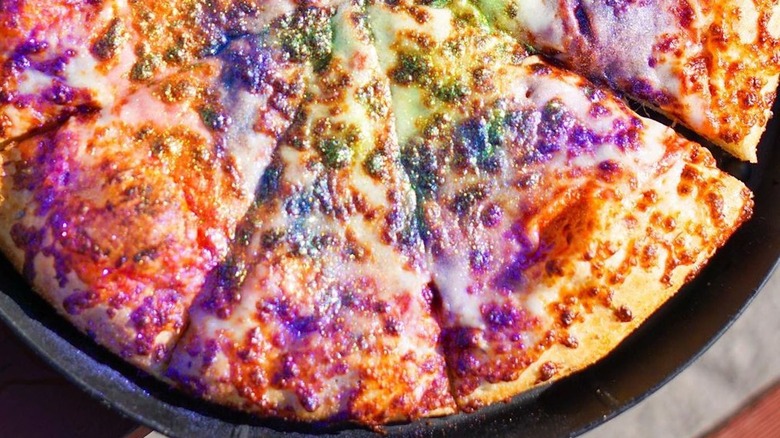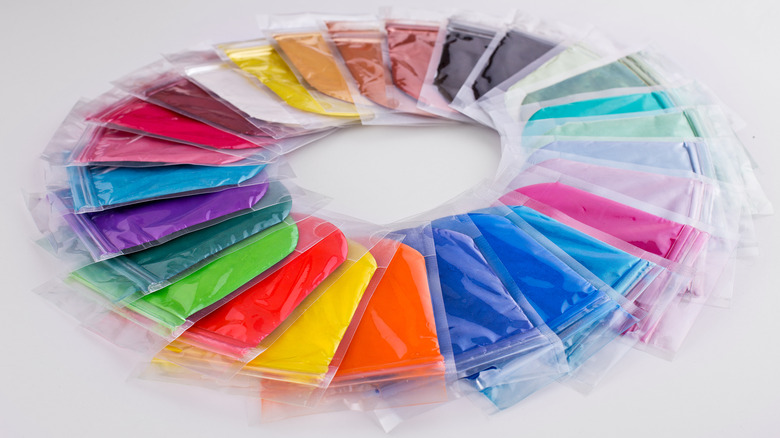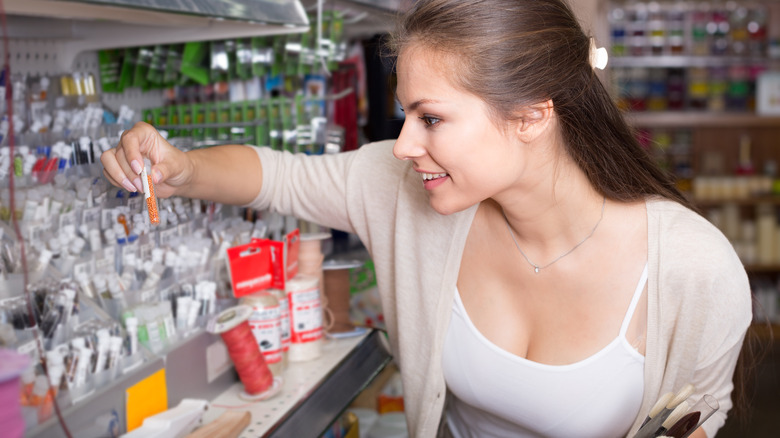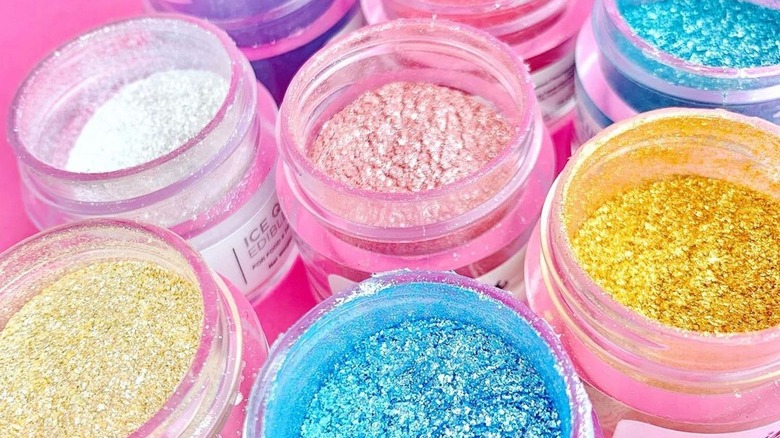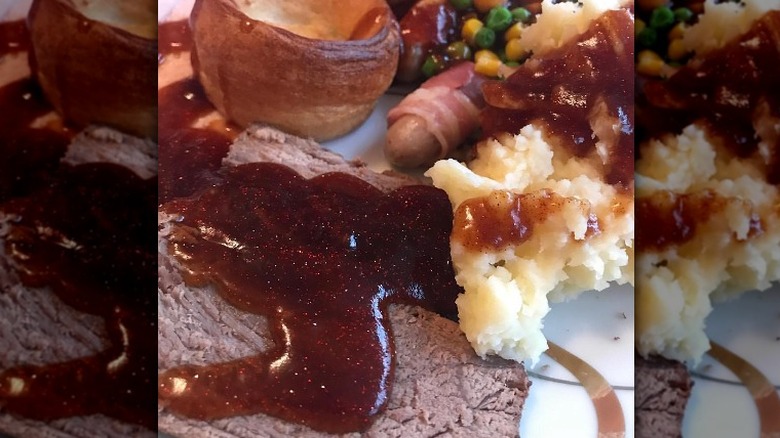What's The Deal With Edible Glitter?
We may receive a commission on purchases made from links.
Marcus Gavius Apicius is the first-century Roman epicurean credited with the famous saying, "We eat first with our eyes," and he never even saw edible glitter (via Brain and Cognition). Once reserved for cupcakes and candy, the dazzling dust is having a moment and might add some luster to a sweet or savory dish near you. The Instagram-able garnish is making fairy tale fare out of everything from pasta to gravy, and people are here for the iridescent eats.
Cookies and cakes are still glinting at the forefront of the edible glitter trend, but Food Network notes that the "disco dust" began moving out of the bakery case and into blinged-out lattes that caught consumers' eye. Bartenders finished beer and cocktails with the glimmering embellishment, bagels started sparkling with all the colors of the rainbow, and pizza was made (even more) magical with a blast of glittery color.
Researchers attribute our love of shiny things to our instinctual ability to find water as it glistens with movement (via the Journal of Consumer Psychology). While water is essential to life, glitter is not a necessary addition to our diet, and it's vital to learn about the shimmering food additive before it goes into our bodies.
What are the ingredients in edible glitter?
According to the Food & Drug Administration (FDA), food-grade edible glitter often contains various combinations of sugar, corn starch, maltodextrin, FD&C (food, drug, and cosmetic) colors, gum arabic, and mica pigments. ABC News notes that in the U.S., edible glitter also sometimes contains titanium dioxide, carmine, and iron oxide.
The Resin Expert explains that mica is a stone with shimmering metallic flecks that provide the eye-catching signature sparkle of glitter. Often used in cosmetics, it's an all-natural, non-toxic mineral deemed safe by the FDA when used sparingly. Carmine is a red pigment that Britannica says is obtained by drying and crushing the bodies of certain insects found in tropical and subtropical climate zones.
Websites and blogs like Key Ingredient offer an alternative to store-bought edible glitter with a simple homemade recipe made of sugar and food coloring dried out in the oven. Users who tried the recipe out note that the homemade version is just colored sugar and doesn't yield the intense shimmer or bold colors of edible glitter that contains mica pigments.
The important difference between non-toxic and edible
Not all that glitters is food, and the FDA wants to make sure that home cooks and food retailers know what they're using before glamming up their dishes with edible glitter. The agency discovered that some food sellers have mistakenly used craft glitter to garnish retail baked goods because it's labeled non-toxic. The Daily Meal notes that many products, like Crayons and Elmer's Glue, carry the same non-toxic label, but nobody is lining up to eat a Play-Doh cupcake. It's important to differentiate between the two labels and know what you're using or buying before consuming it.
According to ABC News, non-toxic glitter is usually made from plastics and metals that aren't meant to be eaten. Delish suggests that home cooks and professional chefs looking to give their food a glow-up with glitter should commit to reading labels and ask food retailers selling glitter-coated goodies to disclose the ingredients of the shimmering garnish before eating the embellishments. Experts agree that while eating edible glitter won't make you ill, consumers still shouldn't ingest it in large amounts. It's best to dust dishes with edible products and a light hand.
As with other colorful but questionable food decor, if the product is marked food-grade and edible, you're good to go, but if it's just non-toxic glitter, it's best to pass.
Where to buy edible glitter
While crafting glitter remains in every other crevice of your home, your kitchen is ready to get set up with FDA-approved edible glitter and all the tools necessary to make your macaroni magical. Consumers should purchase edible glitter from reputable purveyors who comply with all food-grade product requirements.
Edible glitter is available in the dedicated baking section of many craft stores like Michaels, along with other metallic-themed decorations like silver dragees and edible gold leaf. When buying from a store that also carries non-toxic crafting glitter, consumers should ensure that they're purchasing edible glitter that carries a food-grade label. Restaurant supply stores like Sur La Table are also a good source of approved edible glitter and dust. Of course, the only thing that gets in more places than glitter is Amazon, and it has a plethora of edible sparkles and all the gadgets needed to apply them.
Bon Appétit suggests a few tools to help decorators keep their hands glitter-free while applying just the right amount of sparkle. Many edible glitters and luster powders come with a dusting pump that helps you use edible glitter in moderation and target the food instead of everything else in the kitchen; airbrushes give the same effect and are widely used to decorate baked goods. A small mesh strainer gives a light dusting, and fanned make-up brushes make effective applicators also. If these tools aren't included in your purchase, they are often available from the same retailers.
Cooking with glitter
You've done your due diligence by finding a reputable retailer selling food-grade garnishes, double-checked that you're working with an edible product, and now it's time to let your glitter flag fly. A few helpful tips on cooking with edible glitter will yield fancy fare that is sure to delight diners.
When adding luster to baked goods, edible glitter is still widely used as a garnish but can also be baked. The benefit of many edible glitters, like EdiSparklz, is that they are heat stable and won't bleed colors all over your cookies or fall off like traditional sprinkles. Although it bakes well as a topping, Bon Appétit discovered that when edible glitter was worked into dough, it often lost its luster. It's a great way to bring color to baked goods without adding more sugar or imparting random flavors.
All the glittery attention to sweets likely has savory foods feeling like chopped liver, which is now getting its due dose of shimmer. The finishing rule applies to savory foods also, as glitter mostly dissolves when cooked into sauces but shines when used as a garnish. Just be sure to give your sauce a stir before serving to mix in any glitter that has settled to the bottom of the bowl. Pesto is made pretty with vibrant green glimmers, and a salmon filet pops with a pinch of pink glitter. Garnishing with edible glitter is the go-to for glamming up a drab menu.
